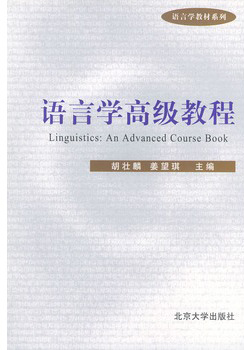- 电子科技大学出版社
- 9787564710729
- 1-1
- 453943
- 45233116-8
- 16开
- 2021-12
- 316
- 文学
- 外国语言文学类
- 英语
- 本科
作者简介
内容简介
本全英文教材Language and Linguistics的主要内容包括语言和语言学研究各个分支学科领域的知识架构,各语言学理论发展流派的主要观点和研究方法。
本全英文教材的主要特色体现在:
1.融入语言学及其各分支领域研究的国际国内最新研究成果,反映国际语言学研究发展的新趋势。
2.立足汉语,在进行语言应用的例证分析时,加大对汉语的分析和汉外语言比较。
3.增加日语语言学和法语语言学两种具体语言的研究理论和研究方法,以适应外国语言文学大类培养需求(含英语、日语和法语三个语种)。
4.增加认知神经语言学、人工智能翻译学等新兴跨学科语言学研究领域,体现文理、文工跨学科交叉融合特色。
本全英文教材的编辑出版,既注重语言学领域的共核基础,又反映语言学研究的最新成果及语言学的新兴交叉学科的研究趋势,体现汉、英、日、法多语贯通融合。本教材适于外语专业本科生、研究生和语言学爱好者。
本全英文教材的主要特色体现在:
1.融入语言学及其各分支领域研究的国际国内最新研究成果,反映国际语言学研究发展的新趋势。
2.立足汉语,在进行语言应用的例证分析时,加大对汉语的分析和汉外语言比较。
3.增加日语语言学和法语语言学两种具体语言的研究理论和研究方法,以适应外国语言文学大类培养需求(含英语、日语和法语三个语种)。
4.增加认知神经语言学、人工智能翻译学等新兴跨学科语言学研究领域,体现文理、文工跨学科交叉融合特色。
本全英文教材的编辑出版,既注重语言学领域的共核基础,又反映语言学研究的最新成果及语言学的新兴交叉学科的研究趋势,体现汉、英、日、法多语贯通融合。本教材适于外语专业本科生、研究生和语言学爱好者。
目录
Chapter 1 Introduction to Language and Linguistics 1
1.1 Language 1
1.2 Origin of Language 1
1.3 Features of Language 2
1.4 Functions of Language 3
1.5 Linguistics 5
1.6 Important Distinctions in Linguistics 8
Chapter 2 Phonetics and Phonology 10
2.1 Branches of Phonetics 10
2.2 Properties of Speech Sound 13
2.3 Phonology 29
2.4 Summary 38
Chapter 3 Morphology 39
3.1 Morpheme, Morph, Allomorph 39
3.2 Classification of Morphemes 39
3.3 Classification of Word-formation Processes 42
Chapter 4 Syntax 49
4.1 Semiotics and Syntax 49
4.2 Traditional Grammar 49
4.3 Structural Grammar 51
4.4 Transformational-generative Grammar 54
4.5 Functional Grammar 88
4.6 Case Grammar 97
4.7 Construction Grammar 100
4.8 Semantics-syntax Interface 105
Chapter 5 Semantics 112
5.1 Denotation, Reference, Sense 112
5.2 Theories of “What Is Meaning” 112
5.3 Classification of Word Meanings 113
5.4 Sense Relations 114
5.5 Componential Analysis 119
Chapter 6 Comparison Between Chinese and English 123
6.1 Stativeness and Dynamicity 124
6.2 Overtness and Covertness 127
6.3 Rigidity and Flexibility 132
6.4 Subjectivity and Objectivity 135
6.5 Abstraction and Concretion 138
6.6 Conclusion 141
Chapter 7 Sociolinguistics 142
7.1 Sociolinguistics and Its Branches 142
7.2 Varieties of Language 144
7.3 Speech as Social Interaction 147
7.4 Language and Culture 150
Chapter 8 Cognitive Neurolinguistics 153
8.1 Introduction to Cognitive Neurolinguistics 153
8.2 Cognitive Neural Mechanisms of Language 157
8.3 The Impact of Language on the Mind and the Brain 167
8.4 Cognitive Neurolinguistic Research Methods and Techniques 174
Chapter 9 Pragmatics 181
9.1 Component View of Anglo-American School 181
9.2 Pragmatic Perspective 218
9.3 Formal Pragmatics 219
Chapter 10 Stylistics 220
10.1 Stylistics and Rhetoric 220
10.2 Style and Stylistics 220
10.3 Development of Stylistics 221
10.4 Stylistic Analysis 222
Chapter 11 Computational Linguistics and Artificial Intelligence in Translation 231
11.1 Computational Linguistics 231
11.2 Corpus Linguistics 233
11.3 Machine Translation 239
11.4 Computer-Aided Translation 244
Chapter 12 Applied Linguistics 253
12.1 Introduction to Applied Linguistics 253
12.2 Language Planning 262
12.3 Language Teaching 265
12.4 Summary 268
Chapter 13 Japanese Linguistics 270
13.1 Phonetics 270
13.2 Writing System 274
13.3 Vocabulary 278
13.4 Grammar 283
Chapter 14 French Linguistics 291
14.1 French and French Linguistics 291
14.2 Representative Linguistic Schools in Contemporary France 293
14.3 Development of French and Linguistics: a Case Study of Discourse Analysis 296
References 300
1.1 Language 1
1.2 Origin of Language 1
1.3 Features of Language 2
1.4 Functions of Language 3
1.5 Linguistics 5
1.6 Important Distinctions in Linguistics 8
Chapter 2 Phonetics and Phonology 10
2.1 Branches of Phonetics 10
2.2 Properties of Speech Sound 13
2.3 Phonology 29
2.4 Summary 38
Chapter 3 Morphology 39
3.1 Morpheme, Morph, Allomorph 39
3.2 Classification of Morphemes 39
3.3 Classification of Word-formation Processes 42
Chapter 4 Syntax 49
4.1 Semiotics and Syntax 49
4.2 Traditional Grammar 49
4.3 Structural Grammar 51
4.4 Transformational-generative Grammar 54
4.5 Functional Grammar 88
4.6 Case Grammar 97
4.7 Construction Grammar 100
4.8 Semantics-syntax Interface 105
Chapter 5 Semantics 112
5.1 Denotation, Reference, Sense 112
5.2 Theories of “What Is Meaning” 112
5.3 Classification of Word Meanings 113
5.4 Sense Relations 114
5.5 Componential Analysis 119
Chapter 6 Comparison Between Chinese and English 123
6.1 Stativeness and Dynamicity 124
6.2 Overtness and Covertness 127
6.3 Rigidity and Flexibility 132
6.4 Subjectivity and Objectivity 135
6.5 Abstraction and Concretion 138
6.6 Conclusion 141
Chapter 7 Sociolinguistics 142
7.1 Sociolinguistics and Its Branches 142
7.2 Varieties of Language 144
7.3 Speech as Social Interaction 147
7.4 Language and Culture 150
Chapter 8 Cognitive Neurolinguistics 153
8.1 Introduction to Cognitive Neurolinguistics 153
8.2 Cognitive Neural Mechanisms of Language 157
8.3 The Impact of Language on the Mind and the Brain 167
8.4 Cognitive Neurolinguistic Research Methods and Techniques 174
Chapter 9 Pragmatics 181
9.1 Component View of Anglo-American School 181
9.2 Pragmatic Perspective 218
9.3 Formal Pragmatics 219
Chapter 10 Stylistics 220
10.1 Stylistics and Rhetoric 220
10.2 Style and Stylistics 220
10.3 Development of Stylistics 221
10.4 Stylistic Analysis 222
Chapter 11 Computational Linguistics and Artificial Intelligence in Translation 231
11.1 Computational Linguistics 231
11.2 Corpus Linguistics 233
11.3 Machine Translation 239
11.4 Computer-Aided Translation 244
Chapter 12 Applied Linguistics 253
12.1 Introduction to Applied Linguistics 253
12.2 Language Planning 262
12.3 Language Teaching 265
12.4 Summary 268
Chapter 13 Japanese Linguistics 270
13.1 Phonetics 270
13.2 Writing System 274
13.3 Vocabulary 278
13.4 Grammar 283
Chapter 14 French Linguistics 291
14.1 French and French Linguistics 291
14.2 Representative Linguistic Schools in Contemporary France 293
14.3 Development of French and Linguistics: a Case Study of Discourse Analysis 296
References 300





